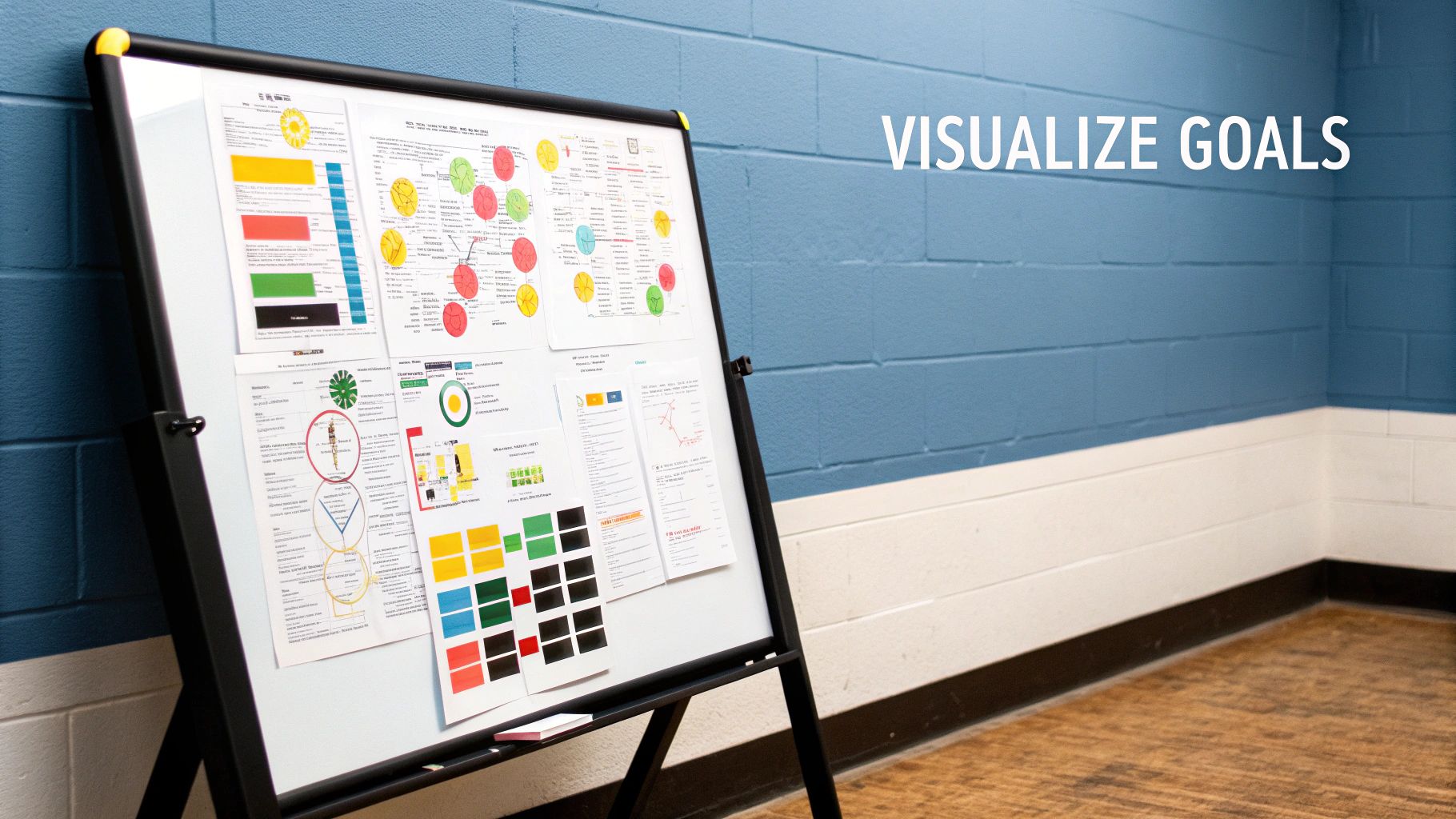Getting Started with Product Roadmap Essentials

A great product roadmap goes far beyond just listing features on a timeline – it's about thoughtfully connecting your product vision to concrete actions. By focusing on key fundamentals, you can build a roadmap that propels your product forward with clear direction and purpose.
Defining Your Product Vision and Strategy
Start with a crystal-clear product vision that guides every roadmap decision. For instance, if you aim to lead the sustainable packaging industry, your strategy might include developing eco-friendly materials and building partnerships with environmentally conscious retailers. When you align each feature with this overarching vision, your roadmap gains focus and momentum.
Identifying Your Target Audience
Great products serve real people with real needs. Take time to deeply understand your target users – their challenges, desires, and goals. Remember that different stakeholders need different levels of detail too. While executives may want high-level summaries, development teams require specific technical requirements. Adapt your roadmap's depth accordingly.
Setting SMART Goals
Clear goals drive measurable progress. Convert vague objectives into specific, measurable targets using the SMART framework. Instead of "boost engagement," aim for "increase daily active users by 15% this quarter." This clarity helps teams focus efforts and track real results.
Choosing the Right Metrics
Data guides smart roadmap decisions and measures genuine progress. Key metrics like Customer Lifetime Value and retention rates reveal how well your product resonates with users. Match your metrics to your goals – if growth is the priority, focus on acquisition costs and conversion rates. This targeted approach keeps your roadmap aligned with business objectives.
Structuring Your Product Roadmap Template
A well-organized roadmap makes complex plans clear and actionable. Group related features into themes or epics and map out dependencies. For example, combine all onboarding improvements under one epic. This structure helps teams understand how pieces fit together, streamlines planning, and ensures resources go where they matter most. By building on these core elements, you create a roadmap that moves your product forward with purpose and precision.
Crafting Templates That Speak to Your Audience

When it comes to product roadmaps, one size definitely does not fit all. Just like you wouldn't use the same sales pitch for every customer, your roadmap needs to flex and adapt for different audiences. The key is creating clear, focused templates that speak directly to each group's specific needs and priorities while maintaining alignment with your core product vision.
Understanding Your Audience's Needs
Think about how different stakeholders interact with your product roadmap. For executives, the focus is strategic – they want to see how your plans drive business growth and market position. A quick executive summary showing major milestones and projected market impact over 3 years works well here. Development teams, on the other hand, need granular details like sprint plans, technical specs, and task dependencies to build effectively. For them, detailed timelines with clear progress tracking are essential to keep work moving forward smoothly.
Tailoring Your Product Roadmap Template
The magic happens when you adapt your roadmap format to match each audience. For executive presentations, stick to high-level strategy and timelines that show the big picture without drowning in details. Product teams benefit most from visual formats like kanban boards that make it easy to track feature progress and dependencies. And sales teams thrive with templates focused on upcoming releases and customer benefits they can share confidently with prospects.
Examples of Effective Template Customization
Leading companies show how powerful customized roadmaps can be. Take Airbnb – they likely maintain separate roadmaps for hosts and guests. The host roadmap might spotlight new property management tools, while the guest version emphasizes personalized travel recommendations. Similarly, Slack probably ensures their developer roadmap highlights API updates and integration opportunities. These examples show how targeted roadmaps help each team stay focused on what matters most to them.
Overcoming Communication Challenges
Of course, managing multiple roadmap versions brings some hurdles. The key is maintaining consistency while meeting diverse needs. Start with core information that appears in all versions – your product vision and strategic goals create a shared foundation. Use consistent terminology and a central platform to keep everyone aligned. For complex organizations, portfolio roadmaps can show how different product lines connect. This helps teams see the full picture and understand how their work fits into broader company goals. With thoughtful planning and clear communication, your roadmap templates become powerful tools for driving product success.
Mastering Visual Roadmap Techniques
The art of creating product roadmaps goes far beyond simple timelines – it's about telling your product's story visually in a way that inspires and aligns your entire team. By thoughtfully selecting visualization methods that resonate with your audience, you can craft a roadmap that brings clarity, drives collaboration, and guides product development.
Choosing the Right Visualization for Your Product Roadmap Template
Not all roadmap visualizations are created equal – the key is finding what works best for your team's needs. For teams focused on hitting specific deadlines, a timeline view excels at mapping out key dates and milestones in chronological order. This approach shines when planning product launches or feature rollouts where timing is critical. On the other hand, agile teams often prefer Kanban boards that emphasize work status and progress over strict timelines. The flexible nature of Kanban boards allows teams to adapt quickly as priorities shift.
Swimlane Views: Empowering Agile Teams
Think of swimlane views like a swimming pool where each lane represents a team or workstream. The design team has their lane, development has theirs, marketing another, and so on. This visual approach makes it crystal clear who owns what work and how different pieces fit together. Teams can easily spot dependencies, avoid bottlenecks, and coordinate their efforts. The result? Better alignment and a shared understanding of how each group contributes to the bigger product vision.
Timeline Views: Highlighting Key Milestones
While swimlanes shine for team coordination, timelines remain essential for communicating the big picture, especially for major launches and releases. A timeline view puts key dates front and center – from beta testing to public launch to full market release. This gives stakeholders and executives the high-level overview they need to track overall progress and understand how the pieces connect over time.
Avoiding Visualization Pitfalls and Maintaining Flexibility
The best roadmap visualizations strike a delicate balance. Too much detail can overwhelm viewers and defeat the purpose of visual clarity. But being too rigid with a single view can make it hard to adapt as circumstances change. The sweet spot is a roadmap that presents information clearly while staying flexible enough to evolve. Keep visuals clean and focused while building in room to adjust course based on new market insights or customer feedback. This creates a "living" roadmap that guides teams while embracing change – exactly what successful product development requires.
Making Data-Driven Roadmap Decisions

Great product roadmaps aren't built on hunches – they're crafted through careful analysis of data and user feedback. When you combine concrete metrics with real user insights, you create a roadmap that truly connects with your audience and drives business growth.
Gathering the Right Data for Your Product Roadmap Template
To make smart roadmap choices, you need both numbers and stories. Start with the quantitative side – track how people use different features, measure conversion rates, and analyze key metrics. For instance, if you notice only 10% of users engage with a particular feature, that's a clear signal to either improve it or remove it entirely. This prevents wasting time on elements that don't resonate with users. Looking at funnel data also reveals where users get stuck, showing exactly where improvements are needed.
But numbers only tell part of the story. The real insights come from talking directly to users through interviews, surveys, and usability tests. This human feedback explains the "why" behind the data – why users skip certain features, abandon purchases, or choose competitors instead. Sometimes low feature engagement isn't due to poor design, but because users don't understand its purpose or value. Only by combining both types of data can you build a complete picture.
Turning Data into Actionable Insights
The key is converting raw information into clear direction for your roadmap. One powerful approach is looking at how different user groups behave over time through cohort analysis. This helps spot patterns among specific segments that inform targeted improvements. For example, by studying users who joined during a particular promotion, you'll better understand what drives long-term engagement. Running A/B tests on feature variations provides solid evidence of what works best, helping optimize the experience based on real results.
Communicating Data-Driven Decisions
Getting stakeholder buy-in requires presenting your data-backed decisions clearly and compellingly. Use visuals like charts and graphs to make complex information easy to grasp. Always connect the dots between roadmap choices and business goals – show how improvements directly impact key metrics. For example, demonstrate how a specific feature enhancement led to 15% more conversions. This builds confidence in your strategic direction. Stay open to feedback and be ready to adjust based on new data. By continuously refining the roadmap through actual results and user input, it becomes a living document that evolves with both user needs and business objectives. The key is making decisions based on evidence rather than assumptions, while remaining flexible enough to adapt as you learn.
Managing Multi-Product Roadmap Success

Product teams managing multiple product lines face a unique challenge – keeping individual products on track while ensuring they work together as part of a unified strategy. Without proper coordination, these product roadmaps can become disconnected silos. That's where portfolio roadmaps come in, offering a high-level view that shows how different product lines connect and support key business goals. Let's explore proven approaches for making multi-product roadmaps work effectively.
Building a Cohesive Portfolio Roadmap
A strong portfolio roadmap starts with mapping out how products relate to each other. For instance, one product might provide core functionality that other products build upon – this dependency needs to be clearly shown. Teams should identify shared resources and technology foundations up front to spot potential conflicts and optimize how they allocate people and tools across products. Like any roadmap, the portfolio view should match its audience – executives may just need the strategic highlights, while product managers require detailed dependency mapping and resourcing plans.
Balancing Competing Priorities and Resources
With limited resources and multiple products needing attention, smart prioritization is essential. Many teams use weighted scoring that looks at market potential, revenue impact, and alignment with strategy to objectively compare opportunities. A product targeting a growing market that strongly supports company goals would score higher than one in a crowded space with weaker strategic fit. The key is finding balance – while it makes sense to invest more in high-impact products, neglecting maintenance of established products can create problems down the line.
Highlighting Cross-Product Initiatives and Dependencies
Portfolio roadmaps help teams spot and manage initiatives that span multiple products. A simple table format works well to show these connections:
| Product | Initiative | Dependency | Timeline |
|---|---|---|---|
| Product A | Feature X | Product B – API Integration | Q2 2024 |
| Product B | API Integration | Q1 2024 | |
| Product C | Feature Y | Product B – API Integration | Q3 2024 |
This clear view helps teams coordinate effectively and avoid duplicate work. When everyone understands how their work impacts other products, they can make smarter decisions that benefit the whole portfolio while staying focused on business objectives.
Learning from Successes and Failures
Past portfolio roadmap experiences offer valuable lessons for improving future plans. Success stories highlight effective practices other teams can adopt. Just as important are the lessons from past challenges – like roadmaps that became too complex and overwhelmed stakeholders. By studying what worked and what didn't, teams can proactively address common pitfalls and keep refining their approach. An openness to learning and adapting is crucial for long-term success with multi-product portfolios.
Keeping Your Roadmap Alive and Relevant
Creating a product roadmap is just the beginning of your journey. The real challenge comes in keeping it vibrant and meaningful as markets shift and internal needs evolve. Your roadmap should be a living, breathing guide that steers your product's growth – not a dusty document that sits in a drawer. Let's explore how successful teams keep their roadmaps fresh and impactful while avoiding common pitfalls.
Regularly Reviewing and Updating Your Roadmap
Think of your roadmap as a GPS that needs regular recalibration. Set up a consistent schedule of reviews – whether monthly or quarterly – to check your progress and make course corrections. Monthly check-ins work well for quick tweaks based on new user insights, while quarterly deep-dives help you step back and assess the bigger picture. Choose a review cadence that matches your product's lifecycle and industry pace. For fast-moving sectors, you may need more frequent updates to stay on track.
Adapting to Change Without Overwhelm
While staying flexible is key, not every small shift requires a roadmap overhaul. Create clear guidelines for what warrants roadmap changes – focus on major market shifts, significant user needs, or core business goals. For example, if a competitor launches a game-changing feature or your key metrics show concerning trends, that's worth addressing. Save smaller feature requests and tweaks for your normal development process. This balanced approach keeps your roadmap focused on strategy rather than getting bogged down in tactics.
Tracking Progress and Measuring Success
Link your roadmap to clear, measurable goals that connect to your product vision. Track metrics like user engagement, acquisition costs, and feature adoption during reviews. Just as a compass shows if you're heading north, these numbers reveal if you're moving toward your targets. Use this data to make smart choices about your product's direction. For instance, if usage data shows a new feature isn't delivering the expected impact, you can adjust priorities or rethink the implementation approach.
Communicating Roadmap Changes Effectively
When updating your roadmap, bring stakeholders along through clear, timely updates. Share the "why" behind changes, grounding decisions in real data and insights. If user feedback points to needed feature shifts, explain how these changes better serve customer needs. Open communication builds trust and keeps everyone aligned with your product's direction. Visual aids like updated roadmap visuals and progress reports can make these updates more engaging and easier to grasp.
Ready to transform your product vision into a tangible reality? MarkBox Studios specializes in crafting Minimum Viable Products (MVPs) and scalable solutions tailored to your unique business needs. We empower founders and entrepreneurs to bring their innovative ideas to life. Visit us at https://www.markboxstudios.com to explore how we can help you build a winning product strategy.



